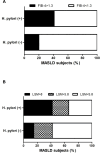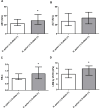The interplay between Helicobacter pylori infection and rs738409 PNPLA3 in metabolic dysfunction-associated steatotic liver disease
- PMID: 39312529
- PMCID: PMC11419387
- DOI: 10.1371/journal.pone.0310361
The interplay between Helicobacter pylori infection and rs738409 PNPLA3 in metabolic dysfunction-associated steatotic liver disease
Abstract
Background: Recent studies have suggested an association between H. pylori and metabolic-disfunction associated fatty liver disease (MASLD). However, epidemiologic studies have yielded inconsistent results. We aim to evaluate the association of H. pylori and G-allele PNPLA3 in MASLD diagnosis, and markers of severity.
Methods: A multi-center cross-sectional study was conducted. A total 224 functional dyspepsia (FD) patients cohort who underwent gastroscopy was selected. Biochemical, clinical parameters, ultrasound, FIB-4 score, LSM by VCTE, gastric biopsies, H. pylori status, and rs738409 PNPLA3 were evaluated. A second retrospective cohort of 86 patients with biopsy-proven MASLD who underwent gastroscopy with gastric biopsies was analyzed.
Results: In the FD cohort MASLD was observed in 52%, and H. pylori-positive in 51%. H. pylori infection was associated with MASLD prevalence, but in multivariate analyses adjusted for G-allele PNPLA3, it became not significant. Then in MASLD-only dyspeptic cohort, H. pylori infection was significantly linked to elevated serum AST levels and increased liver stiffness measurements, suggesting a potential role in liver injury and fibrosis. Histopathological analysis in biopsy-proven MASLD patients further supported these findings, showing a significant association between H. pylori infection and increased NAS score, fibrosis stage, and prevalence of MASH. Notably, the combination of H. pylori infection and G-allele PNPLA3 appeared to exacerbate MASLD severity beyond individual effects.
Conclusions: Our results suggest that H. pylori infection may play a role in the progression of liver injury and fibrosis in patients with MASLD, especially in those with specific genetic predispositions.
Copyright: © 2024 Maiorana et al. This is an open access article distributed under the terms of the Creative Commons Attribution License, which permits unrestricted use, distribution, and reproduction in any medium, provided the original author and source are credited.
Conflict of interest statement
The authors have declared that no competing interests exist.
Figures






Similar articles
-
Helicobacter pylori cagA/vacAs1-m1 strain is associated with high risk of fibrosis in metabolic-dysfunction-associated steatotic liver disease.Ann Hepatol. 2024 Nov-Dec;29(6):101541. doi: 10.1016/j.aohep.2024.101541. Epub 2024 Aug 29. Ann Hepatol. 2024. PMID: 39214252
-
Type 2 diabetes and the minor allele of PNPLA3 consistently identify high-risk metabolic dysfunction associated steatotic liver disease.Diabetes Res Clin Pract. 2025 Jan;219:111960. doi: 10.1016/j.diabres.2024.111960. Epub 2024 Dec 13. Diabetes Res Clin Pract. 2025. PMID: 39675485
-
Use of PNPLA3, TM6SF2, and HSD17B13 for detection of fibrosis in MASLD in the general population.Clin Res Hepatol Gastroenterol. 2024 Aug;48(7):102389. doi: 10.1016/j.clinre.2024.102389. Epub 2024 Jun 1. Clin Res Hepatol Gastroenterol. 2024. PMID: 38830575
-
PNPLA3 variation and kidney disease.Liver Int. 2025 Mar;45(3):e16010. doi: 10.1111/liv.16010. Epub 2024 Jun 14. Liver Int. 2025. PMID: 38873992 Review.
-
Global Epidemiological Impact of PNPLA3 I148M on Liver Disease.Liver Int. 2025 Mar;45(3):e16123. doi: 10.1111/liv.16123. Epub 2024 Oct 7. Liver Int. 2025. PMID: 39373119 Free PMC article. Review.
Cited by
-
Association between Helicobacter pylori infection and metabolic dysfunction-associated steatohepatitis: From an analysis of a population-based study.World J Hepatol. 2025 Feb 27;17(2):102734. doi: 10.4254/wjh.v17.i2.102734. World J Hepatol. 2025. PMID: 40027556 Free PMC article.
-
Co-Occurrence of Helicobacter pylori and Candida spp. Infections in the Pathogenesis of Gastrointestinal Diseases.Biomedicines. 2025 May 11;13(5):1172. doi: 10.3390/biomedicines13051172. Biomedicines. 2025. PMID: 40426999 Free PMC article. Review.
-
Potential mechanisms and therapeutic prospects of the association between Helicobacter pylori infection and metabolic dysfunction-associated steatohepatitis.World J Hepatol. 2025 Jan 27;17(1):101798. doi: 10.4254/wjh.v17.i1.101798. World J Hepatol. 2025. PMID: 39871896 Free PMC article.
-
Polygenic Risk Score for Metabolic Dysfunction-Associated Steatotic Liver Disease and Steatohepatitis: A Narrative Review.Int J Mol Sci. 2025 May 28;26(11):5164. doi: 10.3390/ijms26115164. Int J Mol Sci. 2025. PMID: 40507973 Free PMC article. Review.
-
Prevalence of Helicobacter pylori, Salmonella typhi, Plasmodium falciparum, and Toxoplasma gondii infections and levels of liver function markers among Hepatitis B Virus infected Ghanaians: A cross-sectional study in the Greater Accra Region.PLOS Glob Public Health. 2025 Sep 5;5(9):e0005132. doi: 10.1371/journal.pgph.0005132. eCollection 2025. PLOS Glob Public Health. 2025. PMID: 40911532 Free PMC article.
References
Publication types
MeSH terms
Substances
LinkOut - more resources
Full Text Sources
Medical

